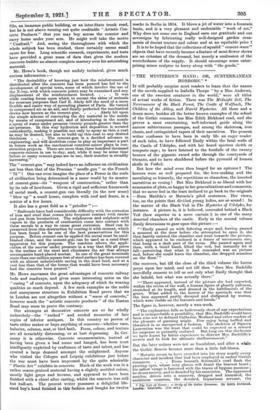'111h MYSTERIOUS HAND ; OR, SUBTERRANEAN HORRORS." *
IT 17611 probably surprise most readers to learn that the names of the novels supplied to Isabella Thorpe " by a Miss Andrews, one of the sweetest creatures in the world," were all titles of actual works of fiction. There was The Midnight Bell, The Necromancer of the Black Forest, The Castle of Wolfbach, The Children of the Abbey, and Horrid Mysteries. All these and a
dozen more, besides all the better known examples of the school of the Gothic romance, has Miss Edith Birkhead read, and she proves a most entertaining, well-informed guide along the narrow subterranean passages, and among the skeletons, iron chests, and extinguished tapers of their narratives. The present writer confesses to have been in early life an eager reader of such tales, to have followed Emily within tho fatal walls of the Castle of Udolpho, and with her heard spectres shriek or tempests rage ; to have listened to the footfalls of the twenty bearers of the gigantic sword echo through the courtyards of Otranto, and to have shuddered before the pyramid of human
skulls in Vathek.
But how the mind even then longed for an epitome I The horrors were so well prepared for, the love-making and the moralizing so leisurely, the repetitions so shameless, the inserted narratives so vexing ! But Miss Birkhead is so liberal with her summaries of plots, so happy in her generalizations and comments, that we never feel in the least inclined to go back to the originals —Rosa Matilda's or Maturin's piled sentences. Her views,
too, on the points that divided young ladies, are so sound ! In the matter of the Black Veil in The Mysteries of Udolpho, for
instance. A picture is, it is believed, concealed behind a Black Veil (how superior to a mere curtain !) in one of the many deserted chambers of the castle. Early in the second volume Emily determines to gaze upon this picture :—
" Emily passed on with faltering stops and, having paused a moment at the door before she attempted to open it, she then hastily entered the chamber and went towards the picture, which appeared to be enclosed in a frame of uncommon size, that hung in a dark part of the room. She paused again and then, with a timid hand, lifted the veil, but instantly let it fall—perceiving that what it had concealed was no picture and, before she could leave the chamber, she dropped senseless on the floor.' " She recovers, but till the close of the third volume the horror preys upon her mind, and not till then " does Mrs. Radcliffe mercifully consent to tell us not only what Emily thought that
she beheld, but what was actually there."
" There appeared, instead of the picture she had expected, within the recess of the wall, a human figure of ghastly paleness, stretched at its length, and dressed in the habiliments of tho grave. What added to the horror of the spectacle was that the face appeared partly decayed and disfigured by worms, which were visible on the features and hands."
The figure is, however, merely a wax-work.
" The explanation falls so ludicrously short of our expectations and is so improbable a possibility, that Mrs. Radcliffe would have been wise not to defraud Catherine Morland and other readers of the pleasure of guessing aright. Few enjoy being baffled and thwarted in so unexpected a fashion. Tho skeleton of Signora Laurentina was the least that could be expected as a reward for suspense so patiently endured. But long ere this disclosure we have learnt by bitter experience to distrust Mrs. Radcliffe's secrets and to look for ultimate disillusionment."
But the later writers were not so fraudulent, and after a while the Gothic flowers become more than a little full-blown.
" Maturin seems to haVe crowded into his story nearly every character and incident that had been employed in earlier Gothic; romances. . . . From beneath Schemoli's cowl flash the piercing eyes, whose very glance will daunt the bravest heart ; his sallow visage is furrowed with the traces of bygone passions ; he shuns society, and is dreaded by his associates. The oppressed maiden, driven into a nunnery, drugged and immured, tho ambitious countess, the devoted, loquacious servant, the • The Tale of Terror : a. Study of the Gothic Romance. BY Edith BlrIthead. London : Constable. Zits. net.) inhuman abbess--all play their accustomed parts. The back- ground shifts from the robber's den to the ruined chapel, from the castle vault to the dungeon of the Inquisition, each scene being admirably suited to the situation contrived, or the emotion displayed. Maturin bad accurately inspected the passages and trap-doors of Otranto. No item, not a rusty lock, not a creaking hinge, had escaped his vigilant eye. He knew in- timately every nook and cranny of Mrs. Radcliffe's Gothic abbeys. He had viewed with trepidation their bloodstained floors, their skeletons and corpses, and had carefully calculated the psychological effect of these properties."
There is much to be said against books about books, but here in The Tale of Terror is a clear case of the advantages of this class of literature. The reader who has ever wondered at some tale of bandit or spectre in a "Keepsake" will find a great deal to amuse him here, while Miss Birkhead's account of the origin of Frankenstein and his monster and of Dr. Drake's experi- ments are of considerable interest, both to the novelist and the psychologist.



































 Previous page
Previous page